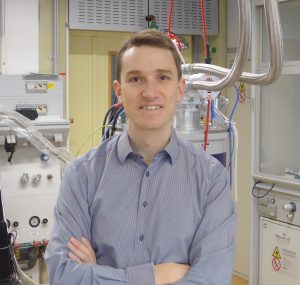ISSP Stay Report of Dr. Clifford HICKS
Clifford, HICKS
Max Planck Institute for Chemical Physics of Solids

At the start of my four-month stay at ISSP I had the fortune to overlap for a month with Profs. Premala Chandra and Piers Coleman. Along with my host, Prof. Nakatsuji, we enjoyed several after-lunch hours discussing PrV2Al20, and experiments that could be done with symmetry-breaking magnetic fields and uniaxial pressure.
I met Prof. Nakatsuji in 2014, when he invited me to give a seminar at ISSP. My specialty is using piezoelectric actuators to place samples under uniaxial stress: to reversibly lift the symmetry of a lattice, and observe how electrical and magnetic properties that depend on that symmetry change in response. The Nakatsuji group synthesises a range of materials whose magnetic and/or topological properties are expected to change qualitatively with reduction in lattice symmetry. This gives us a number of things to talk about. Prof. Nakatsuji recognised promptly in 2014 areas of overlap, and this started a discussion that culminated in my stay at ISSP in summer of 2018.
And I hope that the collaboration will continue from there. These are rewarding but challenging experiments: to withstand large strains while maintaining good strain homogeneity, samples need to be shaped precisely, and then mounted with care. Within my own research group in Dresden it has been an effort of years to develop the processes and tools to do this reliably. During my summer stay we performed preliminary measurements, with a first-generation pressure cell jerry-rigged onto the end of a cryostat insert built for general transport measurements. We then started building a dedicated insert, with more measurement wires and dedicated high-voltage lines for the piezoelectric actuators.
While at ISSP, I also completed design work on a second-generation pressure cell that will allow simultaneous measurement of the stress and strain applied to a sample. Our mutual goal is to put three pressure cells into service in the Nakatsuji group: the first-generation cell mentioned above, this second-generation cell, and a commercial cell with a higher force range. The simultaneous stress and strain measurement capability of the second-generation cell will be extremely useful in identifying stress-induced structural transitions. This cell will accept the same sample carrier that we use in Dresden, which I hope will facilitate long-term
collaboration and exchange of samples.
I enjoyed my stay at ISSP. I am grateful for the opportunity and I am impressed by the range of activities in the Nakatsuji group. I am also grateful to the administrative staff, who made the process of settling in quick and simple. I look forward to many future visits to Japan.
